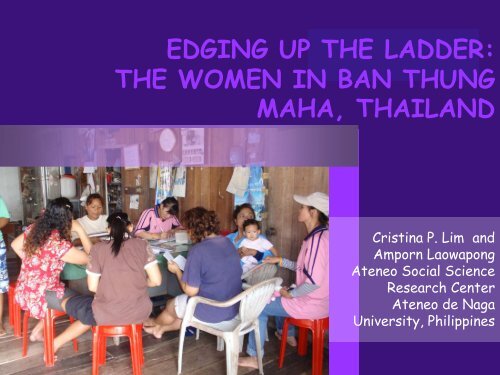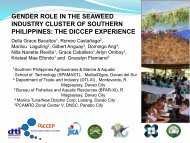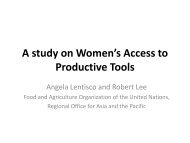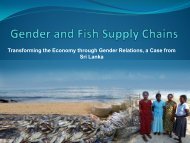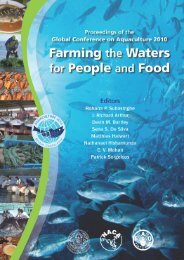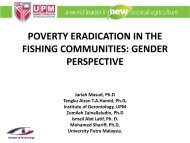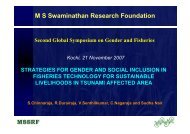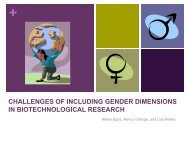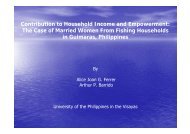Cristina P. Lim - GENDER IN AQUACULTURE AND FISHERIES
Cristina P. Lim - GENDER IN AQUACULTURE AND FISHERIES
Cristina P. Lim - GENDER IN AQUACULTURE AND FISHERIES
Create successful ePaper yourself
Turn your PDF publications into a flip-book with our unique Google optimized e-Paper software.
EDG<strong>IN</strong>G UP THE LADDER:<br />
THE WOMEN <strong>IN</strong> BAN THUNG<br />
MAHA, THAIL<strong>AND</strong><br />
<strong>Cristina</strong> P. <strong>Lim</strong> and<br />
Amporn Laowapong<br />
Ateneo Social Science<br />
Research Center<br />
Ateneo de Naga<br />
University, Philippines
Outline of Presentation<br />
• Brief Background<br />
• Objectives<br />
• Methodology<br />
• Setting<br />
• Findings<br />
• Conclusions and Implications
Brief Brief<br />
17,500.0<br />
17,000.0<br />
16,500.0<br />
16,000.0<br />
15,500.0<br />
15,000.0<br />
14,500.0<br />
14,000.0<br />
13,500.0<br />
Y2001 Y2002 Y2003 Y2004 Y2005 Y2006 Y2007 Y2008<br />
Total Number of Thai Women Employed, 2001-2008.
Number of Thai Women by Occupation, 2008<br />
Legislator, senior officials, managers 273.9<br />
Professionals 887.1<br />
Technicians and associate professionals 807.3<br />
Clerks 878.5<br />
Service workers, shop/market sales workers 3,832.8<br />
Skilled agricultural and fishery workers 6,131.5<br />
Craftsmen and related trade workers 1,209.9<br />
Elementary occupations 2,161.0<br />
Plant and machine operators and assemblers 914.9<br />
Workers not classifiable by occupation 15.5
Fish Farmers and Others Registered with the Department of<br />
Fisheries by Sex, 2007.<br />
Activity F (%) M (%)<br />
No record<br />
(%)<br />
Hatchery and Nursing 26 73 1<br />
Fish Farming 31 66 3<br />
Supplementary Aquatic Food Factories 12 31 57<br />
Fish Products Factor Traders 35 57 8<br />
Middlemen 36 57 7<br />
Primary Fish Processing (Owners) 40 40 23<br />
Cold Storage Facilities (Owners) 16 32 52<br />
Traditional Fish Processing (Owners) 56 39 5<br />
Fish Processing Factories 10 26 64<br />
Importers and Exporters 16 44 39<br />
Ornamental Fish 35 54 11
How are these data reflected at<br />
the local level<br />
What is the situation of women in the fisheries sector in<br />
relation to men<br />
What is the power relation<br />
How is access and control over resources distributed between<br />
men and women<br />
What are the activities engaged in by men and women and how<br />
much time do they allocate<br />
Do women have access to administrative/managerial decision<br />
making positions<br />
How do working women view their work<br />
<br />
Do they still dream for themselves If so, what are these
Objectives<br />
Generally, to know and understand the situation of women in<br />
the fishing village of Thung Maha, Nakhorn Sri<br />
Thammarat, Thailand.<br />
Specifically, it looks into the:<br />
• men and women’s access to and control over resources;<br />
• activities and the time allocation;<br />
• women’s views about their work; and<br />
• their aspirations in life.
Methodology<br />
• Participatory Rapid Appraisal<br />
• Participant Observation<br />
• Key Informant Interview<br />
• Photo Documentation
Study<br />
Site<br />
Thung Maha of<br />
Tambol Pakklong,<br />
Chumphon Province<br />
Auslogics Registry Cleaner.lnk
Ban Thung Maha, Tambol Pakklong,<br />
Chumphon Province<br />
• Ban Thung Maha - one of the seven<br />
villages comprising Tambol Pakklong,<br />
Pathew District, Chumphon Province.<br />
• A Thai-Buddhist community<br />
• Coastal village – Fishing, farming (rice,<br />
palm and rubber), Entrepreneurial<br />
activities.<br />
• In 2002, the number of total households =<br />
196<br />
• Good access roads<br />
• Public transportation to village very limted<br />
hindering one’s mobility very
Access to and control over resources<br />
While access to fishery resources is open, the use and<br />
control of fishery resources, especially of high value offshore<br />
resources, is traditionally assumed by men. Official<br />
registration also bear the names of male fishers.<br />
In general, in farming, ownership and control are assumed by<br />
men. Women helped in managing it.
Activities<br />
F<br />
M<br />
Household<br />
Capture Fishing<br />
Fish culture<br />
Fish processing, marketing<br />
Coconut farming<br />
Coconut marketing<br />
Rubber plantation<br />
Palm plantation<br />
Watching stores/eateries
WOMEN’S<br />
GROUP
‣ The Songkran or “Water Festival” - Thai traditional New Year<br />
(April 13 to 15)<br />
‣ Loi Krathong or festival of floating lights (full moon of 12th month<br />
of the traditional Thai lunar calendar.<br />
People make banana leaf cups (Krathong) and float them to the sea<br />
to drive away the ill fortunes and beg forgiveness of the Goddess<br />
of Water for one’s carelessness in polluting the pristine water of<br />
the river that nourishes all life<br />
‣ During In the birthday celebration of His majesty the king and Her<br />
majesty the Queen (August) - mangrove planting, release of juvenile<br />
sea bass and shrimps and gravid crabs along the shoreline for<br />
conservation, and community cleaning.
COMMUNITY ACTIVITIES<br />
Food preparation<br />
Cleaning of the venue<br />
Help in mangrove planting,<br />
stocking of fish, cleaning<br />
and reforesting the sea<br />
Take the lead in mangrove<br />
planting, stocking of<br />
fish in and cleaning and<br />
reforesting the sea
Village Headship<br />
Public Health<br />
Sports Culture Development Protection<br />
AoBoTor<br />
Public<br />
Relation<br />
Access to Administrative and Decision-<br />
Making Positions
• The above activities affirm the women’s significant<br />
contributions to the fishing village of Thung Maha.<br />
• Women do not only play the major role in the<br />
households but also in fishing and non-fishing activities<br />
such as farming, business, resource conservation and<br />
socio-cultural. Their work complement those of men.
Case stories<br />
‣women in the productive and reproductive spheres<br />
‣how women viewed their works; and<br />
‣aspirations in life
A Fish Processor<br />
• P<strong>IN</strong>. A persistent 62 years old fish processor, first leader of<br />
women’s group, wife to a private fish port operator<br />
Problem: how to be economically independent while taking care of<br />
the housework and family<br />
• Response: Accepted husband’s decision for a while, later,<br />
accepted leadership position, empowered herself, led the women,<br />
engaged in fish processing. Earnings from fish processing allowed<br />
her to purchase tracts of land for rubber plantation without the<br />
knowledge of husband.<br />
• Perception of work: Empowering and fulfilling<br />
• Dream: To travel and see more women empowered and engaged in<br />
productive economic activities
A woman trader<br />
• DAR<strong>IN</strong>A. 37, a hardworking woman trader, married to a 42<br />
years old trader named Dato. She bore him two children, both in<br />
primary school. Darina used to be a fisher, setting out to the sea<br />
with her father at an early age and even with her husband after<br />
marrying him.<br />
• Problem: Unstable income and the risks involved in fishing.<br />
• Response: Engage in less hazardous business - selling banana and<br />
yam fritters and other local sweets.
A woman trader<br />
• Like most of the hardworking women in the fishing village of<br />
Thung Maha, Darina would start her day at 3:00 AM, doing<br />
household chores – cleaning the house, cooking breakfast – and<br />
making local sweets while her husband would prepare the fishballs<br />
and fry bananas and yam for sale in their local shop. At 6:00 AM,<br />
Darina would ride her motorcycle and set off to the rubber<br />
plantation to sell her homemade local sweets to the workers while<br />
Dato would stay home, watch their shop and take care of his<br />
mother and kids. Darina would come home at 1:00 PM, in time for<br />
lunch.<br />
• Darina’s afternoon break would be watching their small shop while<br />
Dato would go to the market to buy yam, bananas and other<br />
ingredients for the preparation of the local sweets. Darina would<br />
take charge of preparing the dinner while Dato would wash the<br />
dishes – an arrangement well accepted by both parties. After<br />
which, both would be watching TV shows. Bedtime is usually at<br />
9:00 PM.
A woman trader<br />
• Perception of Work: Liberating - Darina likes her work because it<br />
allows her to drive around the village, see her friends and be<br />
updated of the latest news in the village.<br />
• Dream: Darina dreamed to own a rubber plantation someday. She<br />
believes that there is so much money in rubber plantation.
An Aquaculturist<br />
• N<strong>IN</strong>, 41, is 2 nd President of the women’s group. A<br />
quiet yet strong woman, Nin is married to Ben, 57, and<br />
bore him two children, already grown up.<br />
• Nin and Bon are hardworking aquaculturist, raising sea<br />
bass in 32 cages measuring 60 square meters each.<br />
Ben is almost always out of the house having to spend<br />
2-3 days attending to his 32 cages for 8 consecutive<br />
months. Nin used to help out in the raising of sea bass<br />
with Ben but with her assumption of the leadership<br />
role, Nin had to divide her time among household<br />
chores, aquaculture activities and management and<br />
operation of the seafood processing activity of the<br />
women’s group.
• Nin would start her day at 6:00 AM, doing household chores –<br />
preparing breakfast, lunch, washing of clothes and cleaning of<br />
the house - before working at the factory. Nin worked full-time<br />
at the factory. She oversaw the processing of the fish -<br />
weighing and packing of the processed fish, receiving and<br />
delivering orders. Nin employed able members of the women’s<br />
group and paid them 200 Baht a day. Nin would stay at the<br />
factory until 6:00 PM, then go home and prepared dinner for<br />
her family. Bedtime for them is usually at 9:00 pm.
A Community Leader and Squid Drier<br />
• Nit, 52 years old, is a committed<br />
community leader. She is married<br />
to Bon, a fishermen. They have 3<br />
children all grown up.<br />
• Nit used to go out fishing with her father when she was little.<br />
When she got married and had children, she stopped going out to<br />
sea and engaged herself in drying squid for additional income.
• Often times, she would<br />
start her day at 5:00 AM,<br />
preparing food and doing<br />
some household chores while<br />
waiting for Bon’s return<br />
from fishing. If Bon’s catch<br />
of squid is not enough, Nit<br />
would buy some more squid<br />
from other fishermen..<br />
• Nit would spend at least 4 hours a day slicing the squid, laying<br />
them out on a flat sheet for drying while Bon would take his<br />
rest. Nit would take a short break during lunch and help Bon<br />
prepare his fishing paraphernalia. After sending Bon off to<br />
the sea, Nit would resume her work, packing some dried squid<br />
and selling them at the nearby market. Oftentimes, Nit would<br />
go home at 5:00 PM, in time for dinner preparation. She<br />
retires to bed early at 8:00 PM.
• Perception of Work: Nit was happy being able to work outside the<br />
house and relegated the work of a community leader in charge of<br />
entertaining the community’s guests. She was also grateful that<br />
her work as squid drier and trader allows her to move around and<br />
socialize with people.<br />
• Dream: None
A Food Shop Owner<br />
• PUK. 37, a food shop owner, is a single parent to a<br />
year old daughter. She got separated from her 35<br />
years old husband 5 years ago, on the ground of<br />
infidelity, not only once but many times. Tired of<br />
being lied to, Puk decided to let go of the<br />
relationship, with the understanding that her<br />
husband, Nyi, would provide some financial<br />
assistance for their kid.<br />
• Problem: No source of Income. Puk’s mother gave<br />
her the restaurant so she would have additional<br />
income.
A Food Shop Owner<br />
• Puk had to wake up at 6:00 AM to ready the shop.<br />
She worked full-time at the shop working until 6 PM<br />
while her mother-in-law would take care of her child.<br />
After which, she would take time to chat with her<br />
friends, go home and rest.<br />
• Perception of work: Uplifting and empowering<br />
• Dream: None.
The stories of these five women clearly illustrate the<br />
power relation between men and women found in the<br />
fishing village which is highly skewed in favor of men, the<br />
highly defined gender-based division of labor, the coexistence<br />
between men and women of fishing communities,<br />
the complementary roles of men and women, and the<br />
struggle of women (Puk and Pin) as they try to resist the<br />
control of men.
The under-representation of women in political and<br />
administrative decision-making positions show the<br />
traditional stereotypes which somehow deprives the<br />
community a large portion of available pool of expertise<br />
which could have been tap for its development efforts.<br />
This stereotyping is also evident in the gender-based<br />
division of labor and the conflicts that emerged between<br />
husband and wife.
The intervention of the Department of Fisheries through<br />
the women organization and provision of skills and livelihood<br />
trainings, although extension of their domestic work,<br />
provided good opportunities for men and women to realize<br />
the development potentials of engaging both in development<br />
efforts particularly in the provision of leadership<br />
opportunities.
Their stories demonstrate how capability trainings have<br />
empowered women by enhancing their self-confidence and<br />
skills in product development and marketing which help<br />
augment their family income, and provided them the<br />
courage to lead others and to determine their life’s<br />
direction, and how good the women are as breadwinners. e<br />
as breadwinners.
Provision of gender sensitivity trainings and education<br />
campaign on women’s rights would help promote gender<br />
equality in the village.<br />
Quantitative measurement of women’s contribution<br />
(productive and reproductive) would be significant in making<br />
visible their contribution and thus, integration in<br />
development planning.
While some women learned to subsume their personal<br />
needs to those of the family to the point of voluntarily<br />
subordinating themselves to men for security, some<br />
learned to resist, pursue their interests and find<br />
themselves, in a matter of time.
THANK YOU!


